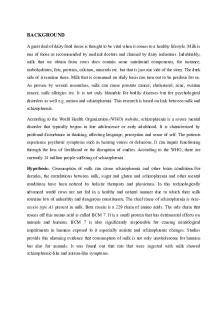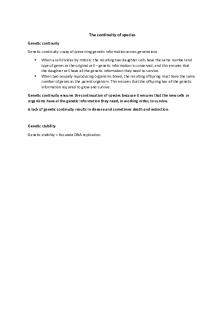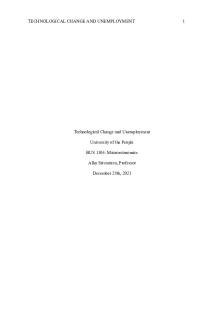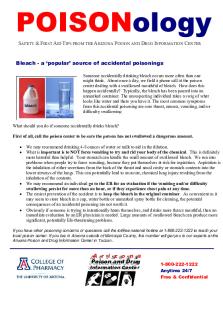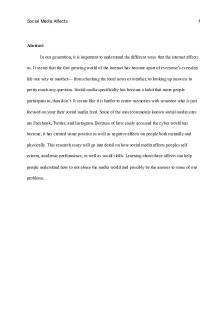Intake of milk and its correlational effects on schizophrenia PDF

| Title | Intake of milk and its correlational effects on schizophrenia |
|---|---|
| Author | Rida Nadeem |
| Course | Neurological Behaviour |
| Institution | Bahria University |
| Pages | 9 |
| File Size | 126.9 KB |
| File Type | |
| Total Downloads | 50 |
| Total Views | 136 |
Summary
Download Intake of milk and its correlational effects on schizophrenia PDF
Description
BACKGROUND A great deal of dairy food items is thought to be vital when it comes to a healthy lifestyle. Milk is one of those as recommended by medical doctors and claimed by dairy industries. Indubitably, milk that we obtain from cows does contain some nutritional components, for instance; carbohydrates, fats, proteins, calcium, minerals etc. but that is just one side of the story. The dark side of it remains there. Milk that is consumed on daily basis can turn out to be perilous for us. As proven by several researches, milk can cause prostate cancer, cholesterol, acne, ovarian cancer, milk allergies etc. It is not only blamable for bodily diseases but for psychological disorders as well e.g. autism and schizophrenia. This research is based on link between milk and schizophrenia. According to the World Health Organization (WHO) website, schizophrenia is a severe mental disorder that typically begins in late adolescence or early adulthood. It is characterized by profound disturbance in thinking, affecting language, perception and sense of self. The patients experience psychotic symptoms such as hearing voices or delusions. It can impair functioning through the loss of livelihood or the disruption of studies. According to the WHO, there are currently 24 million people suffering of schizophrenia. Hypothesis: Consumption of milk can cause schizophrenia and other brain conditions.For decades, the correlations between milk, sugar and gluten and schizophrenia and other mental conditions have been noticed by holistic therapists and physicians. In this technologically advanced world cows are not fed in a healthy and natural manner due to which their milk contains lots of unhealthy and dangerous constituents. The chief cause of schizophrenia is betacasein type A1 present in milk. Beta casein is a 229 chain of amino acids. The side chain that comes off this amino acid is called BCM 7. It is a small protein that has detrimental effects on animals and humans. BCM 7 is also significantly responsible for causing neurological impairments in humans exposed to it especially autistic and schizophrenic changes. Studies provide this alarming evidence that consumption of milk is not only unwholesome for humans but also for animals. It was found out that rats that were ingested with milk showed schizophrenic-like and autism-like symptoms.
INTRODUCTION Milk is the basic source of nutrition for mammals (including humans). It has a lot of health benefits as it has a high nutritional value. Milk is considered to be a complete food item, as it contains proportionate and significant levels of required nutrients such as: protein, fat, carbohydrates, minerals and several vitamins. Its major components are water, lactose, fat, casein, whey proteins and minerals. As far as its physical chemistry is concerned, milk is an opaque, whitish fluid. It contains vitamins, lactose, enzymes, acids and some inorganic salts. Major components of milk are milk solids, water, fat, protein, lactose and minerals. Protein is further simplified into casein and milk protein. Schizophrenia is a severe mental disorder characterized by social behavior that is not normal according to the norms of the society or the culture of a certain area or place. The people affected by this disorder lose touch with reality. Common symptoms of the disorder include delusions, hallucinations, unclear or confused thinking, diminished social expression and lack of motivation. Though the precise cause of schizophrenia is not yet known, researchers believe that a combination of genetics, brain chemistry and environmental factors contribute to development of the disorder. Certain brain chemicals including neurotransmitters especially: dopamine and glutamate may contribute to the causes of schizophrenia. Several neuroimaging studies suggest that people with the disorder have differences in the brain structure and central nervous system. While researchers are not certain of these changes, they indicate that it is a neuropsychiatric disorder. Nutrition may be critical for neurodevelopment and can affect the later development of schizophrenia. There has been a long debate on whether milk components cause neurological disorders such as schizophrenia. Casein is the largest group of proteins found in milk, constituting 80% of the total protein content of milk. Several types of protein have been found in milk, out of which beta-casein is the second most common protein. Beta-casein exists in at least thirteen different forms and the two most common forms of beta-casein are 1. A1 beta-casein 2. A2 beta-casein. A1 beta-casein is found in standard cow’s milk whereas the A2 beta casein is found in human milk and all other mammals’ milk. Some studies indicate that A1 milk may be harmful,
considering A2 milk as a safer option. These two forms of casein are digested differently with only A1 beta-casein releasing betacasomorphin7 (BCM7). Numerous studies have indicated that BCM7 causes health problems and is the real cause of health issues. Several tests have indicated that people with schizophrenia have higher than average BCM7 in their blood. Laboratory studies have also indicated that consumption of A1 milk may increase oxidative stress and may influence early brain development, with possible implications for neuro-developmental disorders. BCM7 has been indicated as the root cause for different neurodevelopmental disorders, as it passes through the bloodstream, it is able to cross through the blood brain barrier. In the brain it can bind to opioid receptors and causes symptoms of schizophrenia and other mood and neuro-developmental disorders.
LITERATURE REVIEW Tempter and Veleber (1980) found positive correlation between consumption of wheat and milk with schizophrenia and a negative correlation with temperature in July, by the data gathered from 18 countries, showing the prevalence of schizophrenia in colder regions around the world. Their findings were forecasted and combined with previous researches. Dohan and Grasberger (1973) randomly assigned two schizophrenic groups on different diets. The group which was on milk and cereal free diet showed twice as better improvement from the patients who had milk and cereal in their diets. When gluten is secretly added in the diet of improved schizophrenic patients, they showed relapse, confirming that gluten present in the milk and cereal causes schizophrenia. Peet (2004) suggested that as physical illnesses are associated with dietary patterns, mental illnesses might have a positive correlation too. Results of an ecological analysis showed that those nations which have high intake of dairy products and refined sugar worsen the schizophrenia. Low intake of seafood and dairy products are associated with high depression prevalence. A study by Taylor and Francis group (2015) performed MRIs on a Siemens Magnetom Trio Tim (3T) system while FreeSurfer software suite was used for volumetric segmentation. Dietary habits related to milk and dairy consumption were assessed by a structured questionnaire. Their
results indicate that dietary habits related with milk and dairy are proportionally associated with volumes of both cerebral cortex and cerebral white matter. Kelly Brogan, MD (2016) suggested that dairy products such as milk can sabotage your brain stimulation and poor digestion with local inflammation. In cow dairy, there are 6 types of protein milk they are: 4 casein comprising 80% and 2 whey. It was founded out that in patients with casein antibodies, there was a 7-8x increase in the diagnosis of schizophrenia, and they have similarly demonstrated a 3-5x increased risk of Bipolar disorder in patients with casein antibodies. Cow dairy milk may also be a source of folate antibodies which can halt our receptors responsible for transporting this critical nutrient to the brain. This study established a linear relationship between these antibodies and exposure to milk which is clearly showing a resolution of antibodies on a milk-free diet and return with reintroduction of milk to live a healthy and a safe life. METHODOLOGY Our research and literature is the link between milk and schizophrenia shows that schizophrenic patients recover better when on a milk free diet. Hence people with schizophrenia can be shifted to other non-dairy milk sources such as almond and soy milk as these do not have the protein casein which is the primary component in regular milk suspected to contribute towards schizophrenia. Also, people who have schizophrenia in their families and are likely to inherit it through their genes can be encouraged early on to switch to non-dairy milk so, to avoid the problems caused by milk that contains casein. Just companion surveyed studies were considered. Human review outlines included were Systematic Reviews, Randomized Controlled Trials (twofold blinded or something else), Cohort thinks about, Case-Controlled reviews and Case Reports. PubMed, Google Scholar and Science Direct were utilized to scan for pertinent reviews identifying with schizophrenia and sustenance. Also, references were followed up and key papers got. The underlying quests (imitated over all databases) consolidated schizophrenia with the accompanying terms and their equivalent words, exchange spellings and contractions:
1.
Nutrient Searches: nourishment; Vitamin A, B (all B-Vitamins and equivalent words), C, D, E; Omega 3 and Omega 6 Polyunsaturated unsaturated fats (and all equivalent words and condensing’s: e.g. EFA's, GLA, EPA and so on.);
2.
Anti-Oxidant Searches: Alpha-lipoic-corrosive; melatonin
3.
Methylation Searches: methylation; Folate; Methyfolate; one-carbon digestion; Vitamin (all B-Vitamins and equivalent words); Vitamin C, E;
4.
Gluten Searches: Celiac Disease; Gluten Intolerance; Gluten;
IMMUNE-MEDIATED RESPONSES AND THE THERAPEUTIC BENEFITS OF CASEIN- AND GLUTEN-FREE DIETS Celiac infection (CD) is an insusceptible interceded condition that prompts irritation of the little intestinal mucosa bringing about harm, loss of absorptive villi and eventually supplement malabsorption. Compact disc is activated by gliadin, a protein found in wheat gluten, and other liquor dissolvable proteins (prolamines) contained in grain and rye. Disposal of gluten reestablishes intestinal mucosa, settle manifestations and enhances personal satisfaction. The connection amongst schizophrenia and CD in kids and youthful grown-ups was seen in clinical settings as ahead of schedule as the 60s. A current populace based case-controlled review which evaluated the lifetime predominance of a scope of immune system issue in schizophrenia found that those with the condition were 3.6 times more prone to be determined to have CD than sound coordinated controls. In a survey of the epidemiological confirmation, Kalaydjian et al. noticed that the normal pervasiveness of CD in those with schizophrenia crosswise over eleven reviews was 2.6%, which is higher that the assessed 1% of analyzed instances of CD in the overall public. Notwithstanding, inquire about has recognized that the counter gliadin safe reaction in schizophrenia may have an alternate antigenic specificity, being autonomous of the activity of transglutaminase protein that is found in those with CD. In a few people with schizophrenia and other psychiatric conditions, for example, nervousness, depressive and temperament issue, consideration shortage hyperactivity issue (ADHD) and a mental imbalance range issue, CD and gluten affectability are conceivably required in the interruption of intestinal penetrability and immunologic variations from the norm, prompting neurologic and psychiatric symptomatology.
ESSENTIAL POLYUNSATURATED FATTY ACIDS (PUFAS) Drain unsaturated fat piece is controlled by a few elements including diet. The drain unsaturated fat profile of dairy bovines is low in polyunsaturated unsaturated fats, particularly those of the n3 arrangement. Endeavors to change and impact unsaturated fat profile with longer chain polyunsaturated unsaturated fats have demonstrated testing. Unsaturated fats constitute around 50-60% of the dry weight of a grown-up human cerebrum, of which 35% is comprised of fundamental polyunsaturated unsaturated fats (EPUFAs). EPUFAs are vital segments of the phospholipids that contain specific cell layers which assume a focal part in the physiology and capacity of the mind. EPUFAs have been speculated as an etiological calculate schizophrenia as ahead of schedule as the 1990s because of discoveries of low levels of EPUFAs in the red platelet films and brains of those with schizophrenia. Notwithstanding oxidative worry, there have been different recommendations in the matter of why levels of EPUFAs are diminished in individuals with schizophrenia including changed neuronal layer digestion and additionally dysregulation of the incendiary reaction framework. Even though the correct system behind the lessened levels of EPUFAs is under civil argument, there have been various reviews researching the viability of EPUFA supplementation in patients with schizophrenia. For instance, in youthful grown-ups giving sub-limit insane states, a 12-week omega-3 EPUFA supplementation program comprising of 700 mg of eicosapentaenoic corrosive (EPA), 480 mg of docosahexaenoic corrosive (DHA), 220 mg of other omega-3 EPUFAs (18:3n3, 18:4n3, 20:4n3, 21:5n3, and 22:5n3) in addition to 7.6 mg of blended tocopherol (Vitamin E) brought down the danger of indications forming into a maniacal issue, when contrasted with fake treatment. In more seasoned grown-ups with schizophrenia bring down levels of red platelet film unsaturated fats were found at standard in contrast with controls. These levels expanded essentially at 4month follow-up after omega-3 EPUFA supplementation joined with vitamin C and E and were related with changes in psychopathology and personal satisfaction. Vitally in this review, members with schizophrenia were coordinated with wellbeing controls on age, sex, ethnicity, eating routine and way of life examples so the distinctions in standard levels of EPUFAs were not because of gathering contrasts. A current survey has recommended that since levels of
unsaturated fats have been appeared to be diminished in the brains of people with schizophrenia, and since this kind of supplementation shows okay of mischief, the expansion of EPUFAs to standard restorative administer to those with schizophrenia might be gainful. EXCLUSION DIETS AS AN ADJUNCT TO ANTI-PSYCHOTIC MEDICATION Number of studies have discovered critical manifestation determination taking after the presentation of a sans gluten abstain from food for patients with schizophrenia, notwithstanding standard care. Early work by Dohan discovered clinical changes in 62% of male patients who got a drain and oat free eating routine. The patients on this eating regimen were moved from a secured tolerant setting to an open ward following a normal of seven days; in correlation, just 36% of the men on a high-grain eating routine were fit to be moved to a less secure setting in this time allotment. A subsequent review duplicated these outcomes and furthermore found that those on the drain and oat free eating methodologies moved from the bolted to the open ward twice as fast as the patient who expended high oat sustenance’s. Unsurprisingly, when gluten was added to the test consume less calories (without patients' or staffs' learning) the impacts vanished in both reviews. Undifferentiated from discoveries were seen in 14 members who were given a drain and grain free eating routine for a month and a half and consequent visually impaired wheat challenge. The changes in 30 out of 30 measures of psychopathy, social evasion and support reduced when gluten was acquainted with the eating regimen yet came back with the wheat was expelled once more. However different reviews have indicated either blended or non-noteworthy outcomes, surmising that avoidance weight control plans may just be helpful for a sub-gathering of individuals with schizophrenia. Besides, as with every one of the intercessions sketched out in this paper, the presentation of rejection eating methodologies ought to just be considered as an extra to conventional pharmacological treatment. VITAMIN D AS A RISK FACTOR FOR THE DEVELOPMENT OF SCHIZOPHRENIA It has been estimated that low pre-birth vitamin D is a hazard figure for the frequency of grownup onset schizophrenia as the absence of this fat-dissolvable vitamin and steroid hormone may unfavorably effect on the creating fetal mind. Investigate utilizing creature models has
demonstrated that low pre-birth vitamin D modifies mental health. Epidemiological information, for example, period of birth (higher pervasiveness of individuals with schizophrenia have been seen to be conceived in winter months), urban birth, higher rates of schizophrenia in vagrant gatherings and pre-birth lack of healthy sustenance have been referred to as support for this theory. In a vast scale birth companion investigation of 9,114 individuals in Finland, the utilization of vitamin D supplements in the primary year of life was related with a diminished danger of creating schizophrenia at 31 years old, with higher dosages seen as more gainful than lower sums. This finding was, in any case, just saw in men, not ladies. Then again in a review taking a gander at ladies just, those with the most elevated dietary admission of Vitamin D had a 37% lower danger of creating crazy like indications contrasted with ladies with the least admission, when controlling for age, add up to vitality consumption, nation of birth, BMI and dietary admission of vitamin B12. In any case, there is proof that high measurements of vitamin D are not really defensive; in 424 coordinated sets from a populace based companion, a bi-modular relationship showed up in which the members with the most minimal and largest amounts of vitamin D had expanded danger of schizophrenia. In this manner, the connection between vitamin D and schizophrenia needs encourage examination, even though a current audit of the proof inferred that sufficient levels of vitamin D are required for ordinary mental health and work and moreover that at-hazard gatherings ought to be offered supplementation.
CONCLUSION: Schizophrenia is a devastating, complex and disabling disorder which limits efficacy in some patients and is often accompanied by severe side effects which require further medication, leading to poor compliance. This review has highlighted a number of possible contributory mechanisms including oxidative stress, one carbon metabolism, essential fatty acid insufficiency and immune-mediated responses that have been observed in individuals with schizophrenia, and documented the nutritional interventions that have been proposed to modify these aberrations. Nutritional strategies offer promise as an adjunct to pharmacological therapy and pose little risk of harm to patients.
However it must be noted that no one treatment is beneficial for all individuals with schizophrenia, different components in milk react differently to different people with the disorder. Nutritional treatment cannot be provided to schizophrenics as research supporting the causes and the underlying physiology of this disorder are still not enough to have a proper understanding of this disorder. Therefore, a more beneficial approach for treating individuals with schizophrenia could be personalized medicine, of which nutritional therapy could play an important part. Within this individualised treatment a patient would be first tested for any deficiencies and physiological abnormalities documented in this paper, with the goal of amending these atypical findings via diet alteration and supplementation. We do not know of any published studies which evaluate such an approach, although this type of treatment is offered by specialized private clinics. Future research should attempt to robustly evaluate such a personalized approach as it appears that schizophrenia may be a spectrum of disorders, rather than a discrete disorder with identical biochemical mechanisms and symptoms. Furthermore, additional research aimed at identifying ...
Similar Free PDFs

Oc spray and its effects
- 3 Pages

Effects of internet on society
- 3 Pages

Effects Of Sitcoms On Teenagers
- 6 Pages

Intake and Output - Garcia
- 5 Pages

Social Media and Effects on Behavior
- 10 Pages

LCT4 intake and output
- 2 Pages
Popular Institutions
- Tinajero National High School - Annex
- Politeknik Caltex Riau
- Yokohama City University
- SGT University
- University of Al-Qadisiyah
- Divine Word College of Vigan
- Techniek College Rotterdam
- Universidade de Santiago
- Universiti Teknologi MARA Cawangan Johor Kampus Pasir Gudang
- Poltekkes Kemenkes Yogyakarta
- Baguio City National High School
- Colegio san marcos
- preparatoria uno
- Centro de Bachillerato Tecnológico Industrial y de Servicios No. 107
- Dalian Maritime University
- Quang Trung Secondary School
- Colegio Tecnológico en Informática
- Corporación Regional de Educación Superior
- Grupo CEDVA
- Dar Al Uloom University
- Centro de Estudios Preuniversitarios de la Universidad Nacional de Ingeniería
- 上智大学
- Aakash International School, Nuna Majara
- San Felipe Neri Catholic School
- Kang Chiao International School - New Taipei City
- Misamis Occidental National High School
- Institución Educativa Escuela Normal Juan Ladrilleros
- Kolehiyo ng Pantukan
- Batanes State College
- Instituto Continental
- Sekolah Menengah Kejuruan Kesehatan Kaltara (Tarakan)
- Colegio de La Inmaculada Concepcion - Cebu
